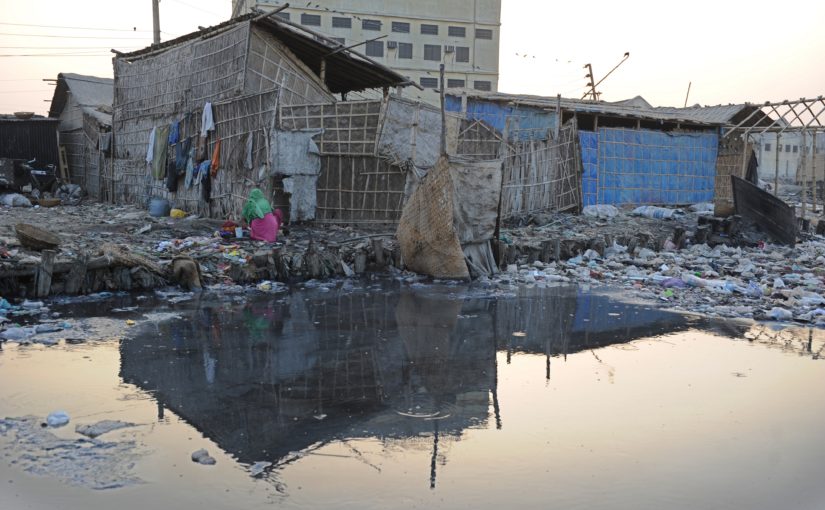Photo Gallery
URBAN POVERTY ISSUES IN BANGLADESH

In recent years in Bangladesh consensus has emerged amongst urban researchers and development practitioners
on the importance of decoupling poverty from a rural context, and the need to understand it in urban terms. But
while urban poverty is now accepted as an issue of its own, it must go beyond being described in simply numeric or
economic terms – as a quantity of people or households below the poverty line. To really understand the complex and
challenging nature of urban poverty, and find workable solutions to respond to it, it needs to be described in a more
nuanced and contextual manner.
AN EXCLUSIVE DISCOURSE
One of the reasons why poverty has been difficult to tackle is that the current discourse on poverty reduction has
been largely confined to the field of economics, and excluding other fields and ways of understanding it. Defined
through an economic lens, using income and assets to identify and quantify the poor population, means that there
has been less attention to other more nuanced factors that contribute to their condition. For example it has not
been understood as a phenomena that is constantly in flux, a dynamic that is changing with trends and subject to
pressures from all around. In an urban setting this might mean that a poor urban poor household – one that might
be relatively wealthier than their rural counterpart – will be susceptible to the rising prices of food items and fuel,
subject to the worsening health conditions of deteriorating public services and infrastructure, and psychologically
and emotionally threatened the threat of eviction. These conditions may spike suddenly, or evolve gradually, resulting
in their constantly living in a vulnerable and precarious condition, despite remaining above what has been deemed
the poverty line.
A PROBLEM WITHOUT A PLACE
Spatial considerations are also important factors in identifying and defining poverty, that hitherto have been
neglected. Where the urban poor live and work has an important bearing upon their capacity to access basic services,
jobs, and also the stigmas that influence their chances of upward mobility. The location of one’s home or community
can determine the health of one’s family, access to quality education, childcare, quality and price of water, even how
much one spends on transportation, and how much time that would take to get to work everyday. Critically, where
one lives also impacts the perception of security one has for one’s property, as a result how much one would invest in
one’s home and surroundings. In short, place or location matters, and the city is a vast and complex world of spatial
relationships. It is important to better understand where the poor are located, and how they relate to other activities,
social infrastructure and services, and for this, spatial information is necessary. At the moment very little urban
data is available, making an insightful and detailed picture that describes the position and conditions of the poor
out of reach.
GETTING THE ISSUE ON THE AGENDA
Due to this lack of understanding and low awareness about urban poverty, it does not feature as a priority in the
public imagination or agenda. Perhaps as a result of this, it also doesn’t feature prominently as a government priority,
which explains the lack of a set of consistent government actions and policies to address it. Since the government
has not reached consensus about how to manage urban poverty – for example through the formulation of a national
policy or plan-, or at the city-level -through mandated poverty reduction action plans and policies- this has resulted
in a systemic neglect for the issues of the urban poor. In addition there are few resources, knowhow, or capacity to
systemically address it.
In the public sphere, urban poverty also does not rank high amongst priorities, with the simplistic belief persisting
that policies that improve the conditions of the poor will only attract more rural migrants and further deteriorate
the conditions of cities. The urban poor are thus victims of lack of awareness about their condition, and a lack of
readiness and willingness to confront its implications for the rest of the city and country.
FINDING SOLUTIONS FROM PROBLEMS
Rapid urbanisation and climate change add further challenges to an already formidable task of reducing poverty
levels in cities. But progress in doing so will not only bring about benefits for the millions living in poor conditions
and insecure livelihoods, it will bring about positive impacts for the country at large. Cities are, after all, the growth
engines of many of Asia’s most successful economies, and ensuring better health, education, housing conditions, and
mobility of the poor, will translate into more productivity and growth for all. This will require massive investments
in infrastructure, extensive social welfare policies, and new thinking about urban planning.